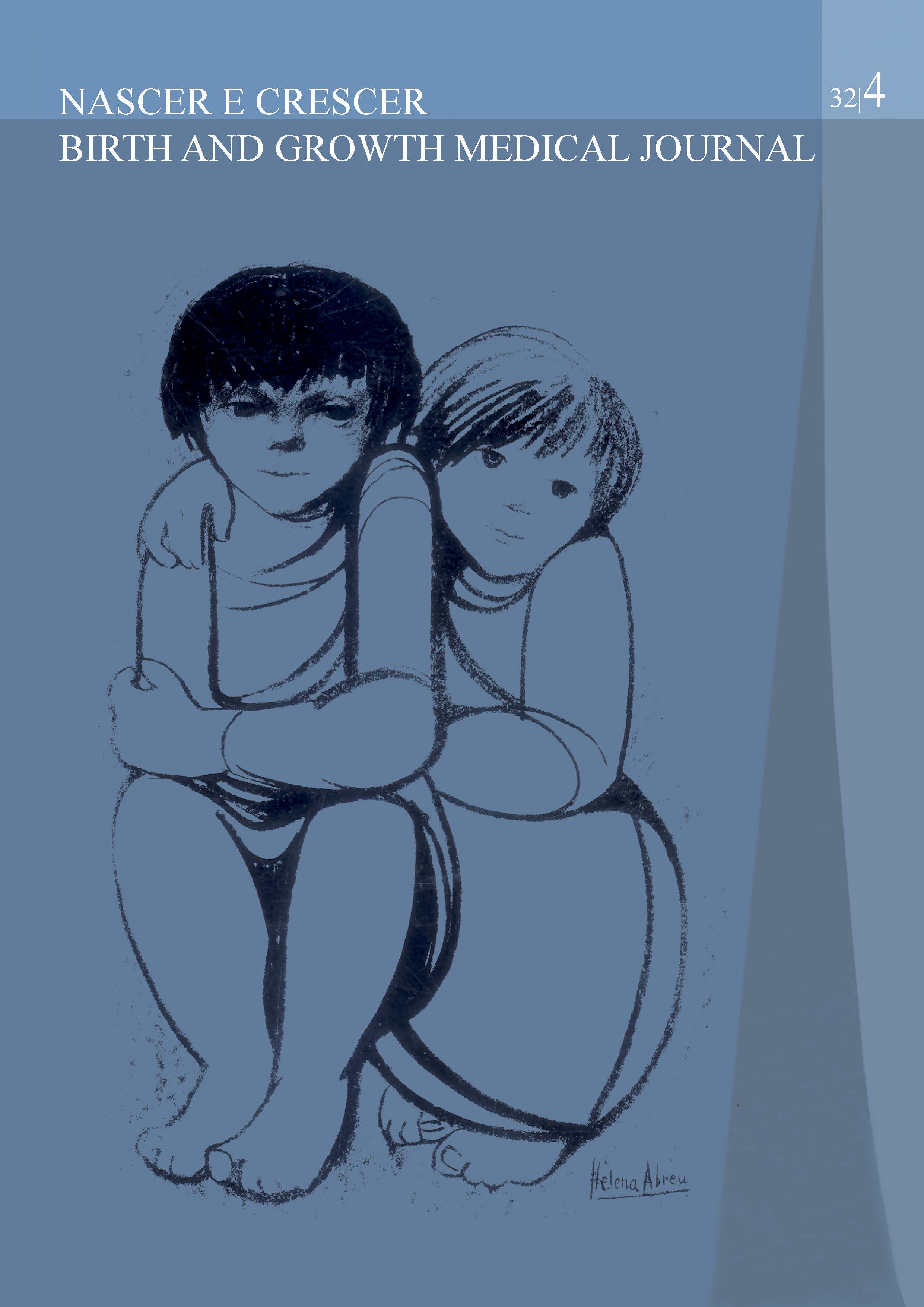Urinary tract infections in a Pediatric Emergency Department – Etiology and antibiotic susceptibility patterns
DOI:
https://doi.org/10.25753/BirthGrowthMJ.v32.i4.30056Keywords:
antimicrobial susceptibility, Pediatrics, urinary tract infectionAbstract
Introduction: Urinary tract infections are common in children. The decision to start empiric antibiotic therapy before isolation of the causative agent must be made based on the clinical presentation and antimicrobial resistance profile of each population. The aim of the present study was to identify the most common etiological agents in urinary tract infections in children and adolescents attending the Pediatric Emergency Department of a level II hospital and the antimicrobial susceptibility pattern, in order to optimize the use of empiric and prophylactic therapy.
Material and Methods: A retrospective analysis of urine cultures with a positive result between January 2019 and December 2021 was performed.
Results: A total of 774 urine cultures were evaluated. The most frequently isolated etiological agents were Escherichia coli (68.5%), Proteus mirabilis (18.1%), and Staphylococcus saprophyticus (4.7%). Escherichia coli showed 4.9% resistance to cefuroxime and 26.2% resistance to amoxicillin-clavulanic acid. Proteus mirabilis showed an adequate susceptibility profile to all empirically used antibiotics. In adolescents, 26.8% of urinary tract infections were caused by Staphylococcus saprophyticus. Ten cases (1.3%) of extended-spectrum beta-lactamase-producing Enterobacteriaceae were identified.
Discussion: Cefuroxime showed an adequate susceptibility profile for all microorganisms. Escherichia coli showed a high resistance rate to amoxicillin-clavulanic acid, exceeding the acceptable resistance threshold for empirical antibiotic therapy. The results suggest an increase in the incidence of urinary tract infections caused by Staphylococcus saprophyticus, which means that the prescription of fosfomycin as first-line empirical therapy for female adolescents should be discouraged.
Downloads
References
Zorc JJ, Kiddoo DA, Shaw KN. Diagnosis and management of pediatric urinary tract infections. Clin Microbiol Rev. 2005;18(2):417-22. https://doi.org/10.1128/CMR.18.2.417-422.2005.
Schlager TA. Urinary tract infections in infants and children. Microbiol Spectr. 2016;4(5).
https://doi.org/10.1128/microbiolspec.UTI-0022- 2016.
Direção Geral de Saúde. Diagnóstico e tratamento da infeção do trato urinário em idade pediátrica. Norma nº. 008/2012 (16/12/2012). Portugal: DGS; 2012.
Rodríguez-Lozano J, Malet A, Cano AE, Rubia L, Wallmann R, Martínez-Martínez L, et al. Antimicrobial susceptibility of microorganisms that cause urinary tract infections in pediatric patients. Enferm Infecc Microbiol Clin. 2018;36(7):417-22. https://doi.org/10.1016/j.eimc.2017.08.003.
Falagas ME, Vouloumanou EK, Togias AG, Karadima M, Kapaskelis AM, Rafailidis PI, et al. Fosfomycin versus other antibiotics for the treatment of cystitis: a meta-analysis of randomized controlled trials. J Antimicrob Chemother. 2010;65:1862-77. https://doi.org/10.1093/jac/dkq237.
National Institute for Health and Care Excellence (NICE). Urinary tract infection (recurrent): antimicrobial prescribing [Internet]; October 2018 [accessed 20 November 2022]. Available at: https://www.nice.org.uk/gUTIdance/ng112.
Organisation for Economic Co-operation and Development; European Centre for Disease Prevention and Control. Antimicrobial resistance tackling the burden in the European Union; 2019 [accessed 2 May 2022]. Available at: https://www.dgs.pt/programa-nacional-de-controlo-da-infeccao/documentos/orientacoes--recomendacoes/antimicrobial-resistance-tackling-the-burden-in-the-european-union-pdf.aspx.
Ramos MH, Vaz CP, Ribeiro, MG, Pinto M., Alves V. Sociedade Portuguesa de Doenças Infeciosas e Microbiologia Clínica. Consenso em Microbiologia Clínica: Uniformização de cartas epidemiológicas hospitalares de apoio à terapêutica antimicrobiana empírica. RPDI. 2017;13(1):44-53.
Kim YH, Yang EM, Kim CJ. Urinary tract infection caused by community-acqUTIred extended-spectrum β-lactamase-producing bacteria in infants. J Pediatr (Rio J). 2017;93(3):260-6. https://doi.org/10.1016/j.jped.2016.06.009.
Agegnehu A, Worku M, Nigussie D, Lulu B, Tadesse BT. Pediatric Febrile Urinary Tract Infection Caused by ESBL Producing Enterobacteriaceae Species. BioMed Research International. 2020;2020:1-8. https://doi.org/10.1155/2020/6679029.
Esposito S, Biasucci G, Pasini A, Predieri B, Vergine G, Crisafi A, et al. Antibiotic Resistance in Paediatric Febrile Urinary Tract Infections. J Glob Antimicrob Resist. 2022;29:499-506. https://doi.org/10.1016/j.jgar.2021.11.003.
Choi U, Kim E, Lyu DH, Kim KS, Park BH, Chung H, et al. The change of antibiotic susceptibility in febrile urinary tract infection in childhood and adolescence during the last decade. Investig Clin Urol. 2022;63(1):99-106. https://doi.org/10.4111/icu.20210350.
Dias A, Oliveira G, Oliveira H, Marques M, Rodrigues F. Bacilos gram-negativos produtores de β-lactamases de espectro expandido num hospital pediátrico. Acta Med Port. 2011;24(S2):197-206.
Mahajan KD, Joshi R. Evaluation of clinical Spectrum, antibiotic Sensitivity, and clinical Outcome in pediatric Age Group (0–18 Years) with Extended-spectrum Beta-lactamase-producing Escherichia coli-associated Urinary Tract Infection in Tertiary Care. Pediatr Infect Dis. 2022;4(4):133-7. https://doi.org/10.5005/jp-journals-10081-1366.
Tamma PD, Aitken SL, Bonomo RA, Mathers AJ, DUTIn D, Clancy CJ. Infectious Diseases Society of America GUTIdance on the Treatment of Extended-Spectrum β-lactamase Producing Enterobacterales (ESBL-E), Carbapenem-Resistant Enterobacterales (CRE), and Pseudomonas aeruginosa with Difficult-to-Treat Resistance (DTR-P. aeruginosa). Clin Infect Dis. 2021;72(7):e169–83. https://doi.org/10.1093/cid/ciaa1478.
Lubowski TJ, Woon JL, Hogan P, Hwang CC. Differences in antimicrobial susceptibility among hospitals in an integrated health system. Infect Control Hosp Epidemiol. 2001;22(6):379-82. https://doi.org/10.1086/501918.
European Committee on Antimicrobial Susceptibility Testing. Expected Phenotypes Version 1.0 February 2022. EUCAST; 2022 [accessed 22 April 2022). Available at: https://www.eucast.org/expert_rules_and_expected_phenotypes/expected_phenotypes/.
The European Committee on Antimicrobial Susceptibility Testing. Breakpoint tables for interpretation of MICs and zone diameters. Version 13.0, 2023 [accessed 13 January 2023). Available at: http://www.eucast.org.
Kahlmeter G. EUCAST Steering Committee. Redefining susceptibility testing categories S, I and R [Internet]. European Committee on Antimicrobial Susceptibility Testing; 2019 [accessed 22 April 2022). Available at: https://www.eucast.org/newsiandr/.
Downloads
Published
How to Cite
Issue
Section
License
Copyright (c) 2024 Paula Santos, Ana Sofia Nascimento, Filomena Santos, Catarina Ribeiro, Julieta Morais

This work is licensed under a Creative Commons Attribution-NonCommercial 4.0 International License.
Copyright and Authors' Rights
All articles published in Nascer e Crescer - Birth and Growth Medical Journal are Open Access and comply with the requirements of funding agencies or academic institutions. For use by third parties, Nascer e Crescer - Birth and Growth Medical Journal adheres to the terms of the Creative Commons License "Attribution - Non-Commercial Use (CC-BY-NC)".
It is the author's responsibility to obtain permission to reproduce figures, tables, etc. from other publications.
Authors must submit a Conflict of Interest statement and an Authorship Form with the submission of the article. An e-mail will be sent to the corresponding author confirming receipt of the manuscript.
Authors are permitted to make their articles available in repositories at their home institutions, provided that they always indicate where the articles were published and adhere to the terms of the Creative Commons license.


